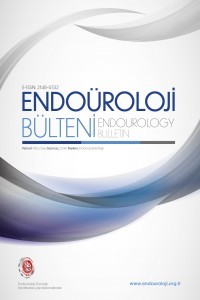
Endoüroloji Bülteni
Yazarlar: Gökhan ECER, Mehmet Giray SÖNMEZ, Mehmet BALASAR, Arif AYDIN, Ahmet ÖZTÜRK
Konular:Üroloji ve Nefroloji
Anahtar Kelimeler:Kidney stones,Flexible ureterorenoscopy,Retrograde intrarenal surgery,Stone free
Özet: Objective: Urinary system stone disease is a common disease in our country. Retrograde intrarenal surgery (RIRS) is currently one of the leading minimally invasive treatment options for stone disease. In this study, we aimed to determine the factors affecting success and complications in patients undergoing RIRS surgery for kidney stones. Material and Methods: A total of 106 patients who were diagnosed with kidney stones and underwent RIRS operation between June 2019 and July 2020 were included in the study. Demographic, radiological, and surgical data of the patients were analyzed retrospectively from the hospital archive. The data were analyzed and interpreted with the SPSS program. Results: It was observed that the groups were similar in terms of demographic data such as age, gender, presence of comorbidities, Body Mass Index (BMI). (Table 1) When we evaluated the stone localizations, it was observed that there were more stones in the upper pole in Group 1, where RIRS success was achieved, and in the lower pole in Group 2 with RIRS failure. (p = 0.027) The average stone size of the patients in our study was 12.7 mm, and it was found as 12.02 mm in Group 1 and 18.3 mm in Group 2. (p = 0.004) When the lower pole infundibulopelvic angles of the patients were measured from CT images, it was measured as 55.8 ° in Group 1 and 48.2 ° in Group 2. It was determined that group 1 was statistically significantly higher (p = 0.02). There was no statistically significant difference between the mean operation time, stone density, fluoroscopy time, and preoperative serum creatinine levels. Conclusion: In our study, the factors affecting the success of RIRS were stone location, stone size, and lower pole infundibulopelvic angle. Low complication rates and high stone-free rates can be obtained when used in appropriate patients. It can be chosen as a method that can be used effectively in patients with smaller sizes and fewer kidney stones, who do not have anatomical problems in terms of access to the kidney.